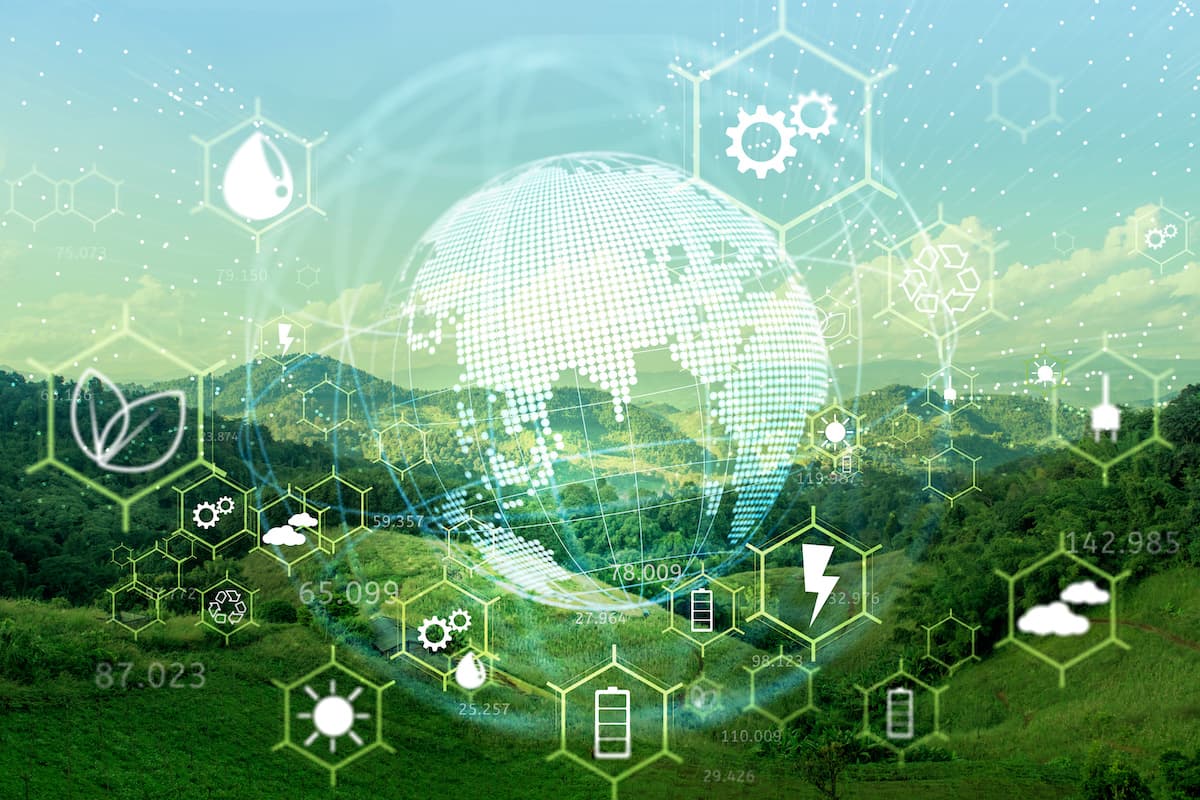The Concept of Green Technology in the Modern World
his 2000-word exploration will delve deep into the concept of green technology, its significance in the modern world

In an era marked by environmental challenges and a growing consciousness of our planet's finite resources, the concept of green technology has emerged as a beacon of hope. Also known as clean technology or eco-friendly technology, green technology encompasses a diverse range of innovations aimed at mitigating the environmental impact of human activities. This 2000-word exploration will delve deep into the concept of green technology, its significance in the modern world, and how it is shaping our sustainable future.
Understanding Green Technology
Before we dive into the profound impact of green technology, let's start by understanding what it entails:
1. Sustainability and Environmental Responsibility
At its core, green technologies embodies the principles of sustainability and environmental responsibility. It seeks to develop products, processes, and systems that minimize harm to the environment and conserve natural resources.
2. Innovation and Efficiency
Green technology is synonymous with innovation and efficiency. It strives to create solutions that are not only environmentally friendly but also economically viable. This often involves finding new ways to produce energy, reduce waste, and optimize resource use.
3. Diverse Applications
The scope of green technologies is vast, spanning various sectors, including energy, transportation, agriculture, construction, and more. From solar panels to electric vehicles, it touches nearly every aspect of modern life.
4. Global Collaboration
Green technology is a global endeavor that relies on collaboration between governments, industries, research institutions, and individuals. International agreements and partnerships play a crucial role in advancing green technology on a global scale.
The Significance of Green Technology in the Modern World
In today's world, green technology has assumed immense significance due to a confluence of factors that make sustainability a top priority. Let's explore why green technology matters so much in our contemporary context:
1. Climate Change Mitigation
The modern world faces the urgent challenge of mitigating climate change. Green technology offers a path to reduce greenhouse gas emissions by transitioning to renewable energy sources, enhancing energy efficiency, and adopting sustainable practices across industries.
2. Resource Conservation
As global populations grow and resource scarcity looms, the efficient use of resources becomes paramount. Green technology plays a crucial role in conserving resources such as water, land, minerals, and rare earth elements.
3. Air and Water Quality
Addressing air and water pollution is a pressing concern in densely populated urban areas. Green technologies solutions like electric vehicles, air purifiers, and wastewater treatment systems improve the quality of life by reducing pollutants.
4. Economic Growth and Job Creation
The green technologies sector offers economic opportunities and job creation. As industries transition to sustainable practices, new markets and employment opportunities emerge in renewable energy, eco-friendly construction, and green manufacturing.
5. Resilience and Adaptation
With the increasing frequency of natural disasters and extreme weather events, green technology can enhance resilience and adaptation. This includes the development of resilient infrastructure, flood-resistant buildings, and disaster recovery solutions.
6. Biodiversity Conservation Green Technology
Protecting biodiversity is crucial for ecosystem health and human well-being. Green technology can aid in habitat restoration, sustainable agriculture, and wildlife conservation efforts.
Key Areas of Green Technology Advancements
To appreciate the breadth of green technology's influence, let's explore some key areas of advancement and innovation:
1. Renewable Energy
Renewable energy sources like solar, wind, hydro, and geothermal power are at the forefront of green technologies. They offer sustainable alternatives to fossil fuels and have witnessed exponential growth in recent years.
2. Energy Efficiency
Improving energy efficiency is a cornerstone of green technologies. Innovations in LED lighting, smart buildings, and energy-efficient appliances help reduce energy consumption and carbon emissions.
3. Electric Mobility
The transition to electric vehicles (EVs) is reshaping the transportation sector. EVs offer reduced emissions, quieter operation, and the potential to decarbonize the entire automotive industry.
4. Sustainable Agriculture
Green technology in agriculture includes precision farming, organic practices, and the development of drought-resistant crops. These innovations contribute to sustainable food production and reduce the environmental impact of agriculture.
5. Waste Reduction and Recycling
Innovations in waste reduction and recycling technologies are critical for managing our waste streams. From advanced recycling facilities to biodegradable packaging materials, green technologies is transforming waste management.
6. Water Purification and Green Technology
Clean water is essential for life, and green technologies is making strides in water purification and conservation. Desalination technologies, efficient irrigation systems, and wastewater treatment plants help ensure access to clean water.
7. Sustainable Construction
The construction industry is adopting green building practices, including the use of sustainable materials, energy-efficient designs, and eco-friendly construction processes.
8. Circular Economy
The concept of a circular economy promotes the reuse, recycling, and repurposing of products and materials. Green technology supports this transition by developing innovative methods for reusing resources.
Real-World Examples of Green Technology
To grasp the tangible impact of green technologies, let's explore some real-world examples:
1. Electric Vehicles
Electric cars, buses, and bicycles are gaining popularity as alternatives to traditional fossil-fueled vehicles. They offer lower emissions and reduced dependence on oil.
2. Energy-Efficient Appliances
Energy-efficient appliances, such as Energy Star-rated refrigerators and LED lighting, reduce electricity consumption and utility bills while minimizing environmental impact.
3. Smart Grids
Smart grids use advanced technology to optimize the distribution of electricity. They enhance reliability, reduce energy losses, and incorporate renewable energy sources into the grid.
4. Sustainable Packaging
Biodegradable and recyclable packaging materials, such as compostable plastics and cardboard alternatives, are reducing the environmental footprint of consumer products.
5. Water Purification Green Technology
Advanced water purification systems, including reverse osmosis and UV treatment, provide clean drinking water in areas with limited access to freshwater sources.
6. Green Building Materials
Sustainable building materials, such as bamboo flooring and recycled-content insulation, contribute to eco-friendly construction practices.
The Challenges and Future of Green Technology
While green technology holds immense promise, it also faces significant challenges:
1. Initial Costs
The upfront costs of implementing green technologies can be high. However, long-term savings in energy bills and reduced environmental impact often outweigh these initial investments.
2. Infrastructure and Adoption
Updating existing infrastructure to accommodate green technologies can be a logistical challenge. Widespread adoption requires government incentives and industry cooperation.
3. Technological Advancements
Green technology is continually evolving. Keeping up with the latest advancements requires ongoing research and development efforts.
4. Regulatory Support
Effective regulation and policies are essential to support the growth of green technologies. Governments must create incentives for sustainable practices and set emissions reduction targets.
5. Global Collaboration
Solving environmental challenges requires global collaboration. International agreements and cooperation are crucial for addressing issues like climate change.
A Greener Tomorrow
Green technology is not a mere trend; it is a necessity for our planet's well-being and the future of humanity. It represents our collective commitment to addressing environmental challenges, conserving resources, and transitioning to sustainable practices. As individuals, communities, businesses, and governments embrace green technologies, we move closer to a greener, cleaner, and more sustainable tomorrow.
The concept of green technologies in the modern world is a beacon of hope, illuminating a path toward a future where innovation, efficiency, and environmental responsibility go hand in hand. By harnessing the power of green technology, we can mitigate the impacts of climate change, protect biodiversity, and create a world where sustainability is not an option but a way of life.
In this journey, our collective efforts and investments in green technologies will define the legacy we leave for future generations a legacy of responsible stewardship of our planet and a commitment to a brighter, more sustainable future.
As we reflect on the significance of green technologies in the modern world, let us remember that each choice we make, whether as individuals or as a society, contributes to shaping the future we envision. Embracing green technology is not just a technological shift; it is a transformative journey towards a more harmonious coexistence with our planet.
What's Your Reaction?




















